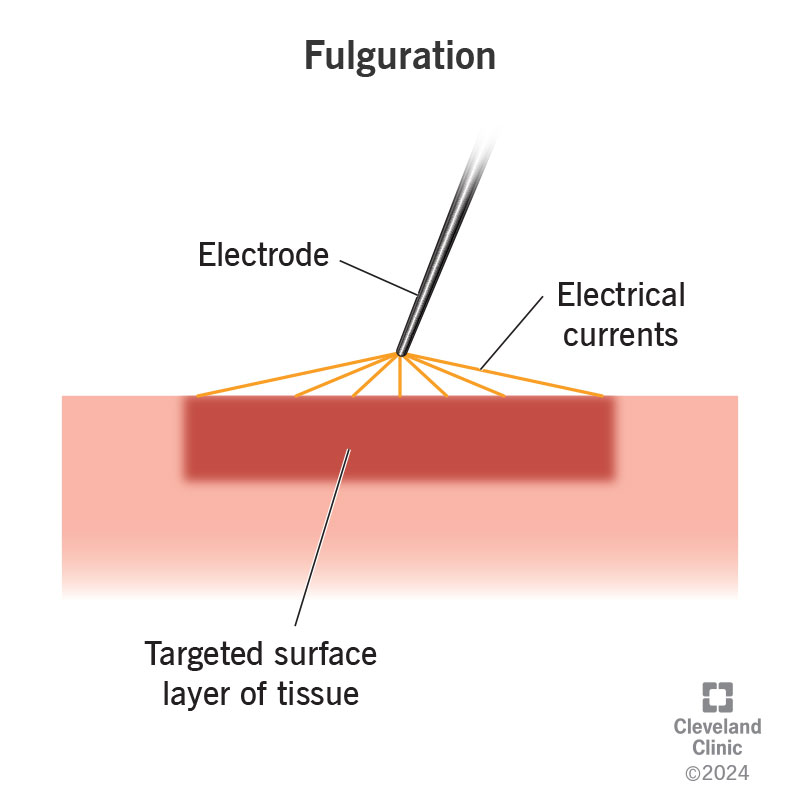Fulguration is a treatment that uses electrical currents to destroy abnormal cells. A type of electrosurgery, fulguration generates a spark that destroys the cells. It’s used to treat benign, precancerous and cancerous growths. Examples include bladder fulguration and fulguration for cervical dysplasia.
Advertisement
Cleveland Clinic is a non-profit academic medical center. Advertising on our site helps support our mission. We do not endorse non-Cleveland Clinic products or services. Policy

Image content: This image is available to view online.
View image online (https://my.clevelandclinic.org/-/scassets/Images/org/health/articles/fulguration)
Fulguration (electrofulguration) is a type of electrosurgery — a treatment that uses electricity to heat and destroy abnormal cells. Like other electrosurgery, fulguration operates on a simple principle: Heat can heal. Instead of making physical cuts, or incisions, it uses electrical currents to remove atypical cells. The science behind how this process works depends on the type of electrosurgery.
Advertisement
Cleveland Clinic is a non-profit academic medical center. Advertising on our site helps support our mission. We do not endorse non-Cleveland Clinic products or services. Policy
With fulguration, healthcare providers use a probe with an electrode at the end to direct energy toward the treatment area. The electrode creates a spark that generates enough heat to kill the targeted cells.
Sometimes, the probe has a tiny wire loop on the end that carries the electrical current. The type of instrument your provider uses depends on the specific procedure.
Healthcare providers use fulguration to destroy cells causing benign, precancerous or cancerous growths. Sometimes, providers use fulguration to stop bleeding after traditional surgery.
Providers use fulguration to treat:
Advertisement
There isn’t one set way to prepare. Be sure to follow your healthcare provider’s instructions about:
The specifics of what happens varies by procedure, but general steps include:
In bladder cancer surgery, healthcare providers use fulguration as part of a procedure to diagnose and treat tumors called transurethral resection of bladder tumor (TURBT).
Healthcare providers use a rigid instrument called a resectoscope to access your bladder and remove tumors. The resectoscope has a tiny wire loop that can carry electrical currents. Providers use the loop to surgically remove the tumor. Then, they use fulguration to destroy any remaining cancer cells and stop the bleeding.
Healthcare providers use fulguration as part of a procedure to diagnose and treat cervical dysplasia called loop electrosurgical excision procedure (LEEP).
Surgery involves gently inserting a speculum into your vagina so your provider can see your cervix. After injecting or placing a numbing medication on your cervix, your healthcare provider guides a loop made of thin, electrically charged wire to your cervix. The loop passes over your cervix. It cuts a thin layer of tissue containing abnormal cells with each pass.
You’ll need some time to recover before leaving your healthcare provider’s office or facility. With most procedures that use fulguration, you’ll get to go home that same day.
Advertisement
Fulguration is a minimally invasive treatment for some conditions, which doesn’t require large incisions or cuts.
For skin conditions, fulguration often helps get rid of growths for good. Other times, fulguration can help manage the condition. For example, fulguration can destroy tissue causing pesky symptoms if you get recurrent UTIs or if you have endometriosis. It can get rid of early-stage bladder cancers, although sometimes, the tumors return.
Ask your healthcare provider about the benefits of fulguration based on your diagnosis.
The most common complication involving fulguration is delayed bleeding. Your healthcare provider will tell you what to do if a wound on your skin starts bleeding. Usually, applying direct pressure for 20 minutes resolves the issue. You may notice blood in your pee after bladder fulguration and vaginal bleeding following cervical fulguration.
Fulguration, like any electrosurgery, carries some risks. But it’s important to know that providers who use fulguration complete training focused on minimizing them. Potential risks include:
Advertisement
Healthcare providers use fulguration for different procedures. Each has different recovery times.
Before your procedure, ask your healthcare provider what to expect after your procedure, including:
Contact your provider any time you have the following symptoms:
Cauterization and fulguration are similar in that they both use electrical currents to generate heat that destroys atypical cells. But the flow of electricity is different.
Cauterization uses a direct current (DC). This means that the current travels from the electrode to the tissue, burning it. It’s a one-way trip. Electrosurgical procedures (like fulguration) use an alternating current (AC). The current travels back and forth between tissue and electrode, generating more heat as it passes through cell layers.
The science is complex, but the type of current flow that works best depends on the treatment you need.
Fulguration and ablation aren’t the same, but there’s overlap. Ablation therapy uses different types of energy sources to “ablate” (get rid of) atypical cells. Energy types include microwaves, high-energy radiofrequency, lasers or extreme cold (cryoablation). Fulguration is a specific way of delivering electricity (with a probe and an electrode) to destroy atypical cells.
Advertisement
Using electricity as a medical treatment might sound like science fiction. But electrosurgery has been around for centuries. Fulguration is a medical mainstay that dates back to the early 1900s. Healthcare providers of that time named the process after the Latin term for lightning because fulguration creates sparks to generate healing heat.
Healthcare providers take care to use fulguration to heal while keeping you safe. If your healthcare provider recommends fulguration, ask them for procedure details so you understand how electrosurgery can power your medical treatment.
Learn more about the Health Library and our editorial process.
Cleveland Clinic's health articles are based on evidence-backed information and review by medical professionals to ensure accuracy, reliability, and up-to-date clinical standards.
Cleveland Clinic's health articles are based on evidence-backed information and review by medical professionals to ensure accuracy, reliability, and up-to-date clinical standards.
Cleveland Clinic’s primary care providers offer lifelong medical care. From sinus infections and high blood pressure to preventive screening, we’re here for you.
